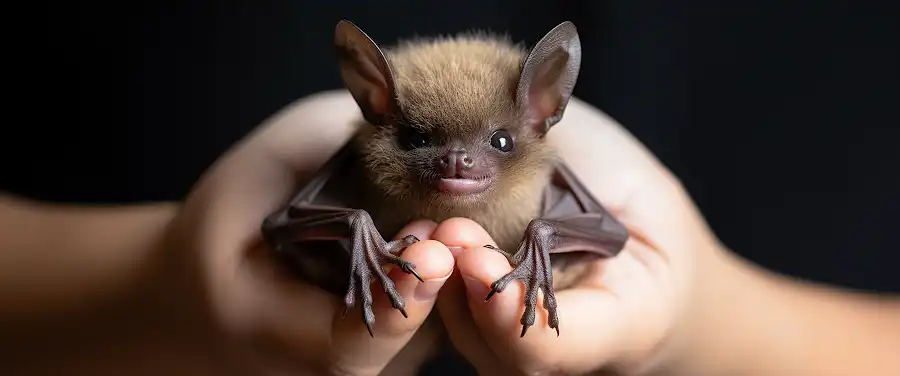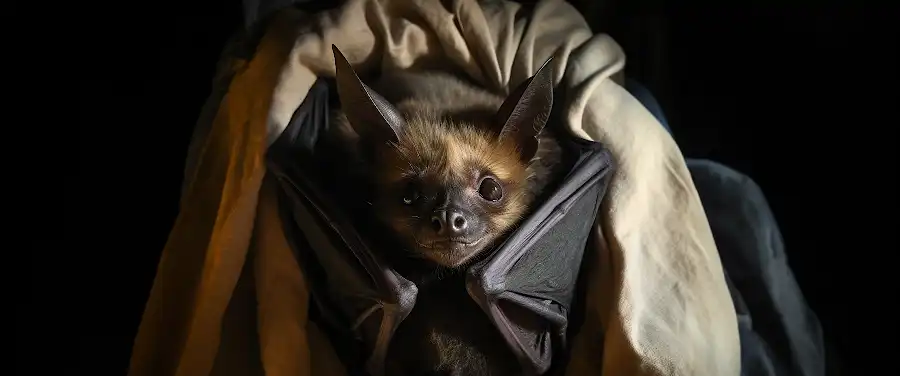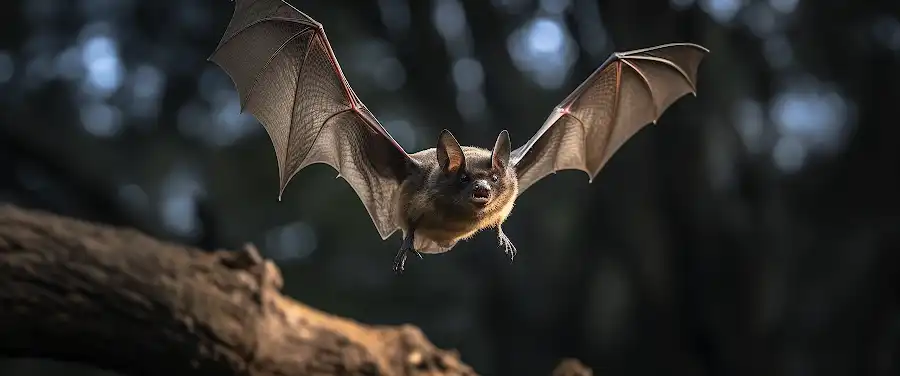
Staring up into the Central Florida twilight, one can’t help but marvel at the silhouettes quietly flitting across the evening sky. Catching your eye with their intricate aerial acrobatics, these elusive wonders of the night aren’t birds, but bats. Filled with an astounding array of shapes, sizes, and habits, the bat species of Central Florida make up a truly intriguing and often misunderstood part of our environment.
Central Florida’s unique location between two climatic regions creates a melting pot for a diverse range of these enchanting and cryptic creatures. Nestled between the tropical ecosystems of South Florida and the temperate forests of the North, this biodiversity hotspot is home to an impressive 13 bat species. From the famed Florida Bonneted Bat to the captivating Evening Bat, there is a world of diversity waiting to be discovered. You’ll find them hidden in tree crevices, hollowed-out logs, and even in your garden bat box, each with a story desperately waiting to be relayed.
But why should we care about this invisible diversity up in the air? Why should we pay attention to these creatures of darkness, often overlooked, mostly misunderstood, and even feared by many? Understanding these fascinating mammals demands a deeper look into their silent lives, their countless contributions, and the dangers they face. As we delve into the intricacies of the bat species in Central Florida, we’ll explore their behavioral characteristics, ecological significance, and the need for their conservation. Time to wrap your fingers around that cup of late-night cocoa and settle in for a foray into Central Florida’s nightlife. Next, let’s unfold the answers to this intriguing question: Why should we care about bats in Central Florida?
What are the Predominant Bat Species in Central Florida?

Welcome to the nightlife of Central Florida, a unique world which is abode for a diversity of species in the animal kingdom. While you might have been well aware of the charismatic fauna in the sunshine state, today we will introduce you to the lesser-known inhabitants of the night – the bats.
Intriguing, nocturnal, and vital for the environment, bats in Central Florida contribute significantly to pest control and seed dispersion. Let’s get introduced to the few significant species that call Central Florida their home: the Brazilian Free-tailed Bat, the Evening Bat, the Florida Bonneted Bat, and the Southeastern Myotis.
The Brazilian Free-tailed Bat, also known as Tadarida brasiliensis, is quite abundant in the state. Highly mobile, they can fly to altitudes of nearly 10,000 feet. They are known for their high-speed flight, a trait which they leverage to feed on insects during nightfall.
The Evening Bat (Nycticeius humeralis) is small in size but holds a big role in the local ecosystem. These tiny critters consume various types of insects, acting as a natural pesticide. They usually roost in tree cavities, buildings, and sometimes even in bat houses, making them a common neighbour in many Central Florida homes.
The Florida Bonneted Bat, also known as Eumops floridanus, is the rarest and largest bat species in the state. They are particularly significant as they are endemic to Florida and are classified as a federally endangered species.
We cannot forget the Southeastern Myotis (Myotis austroriparius), which, unlike most bats, prefer to call water bodies their home. They roost in spaces like caves, bridges, and buildings near water, particularly during their maternity season.
How do these Bat Species Differ from Each Other?
Each bat species in Central Florida is unique, not just in terms of physical attributes but also their roosting habits, dietary preferences, and reproductive behaviors, demonstrating a fascinating variety in lifestyle within the bat community.
Physically, each species presents unique features, like the free-tailed bat’s tail extending beyond its tail membrane, or the Florida Bonneted Bat’s large ears and bonnet-like appearance, thus the name.
When it comes to their nests or roosting habits, the differences are apparent as well. For instance, while the Evening bat might prefer a comfortable tree hollow or a cozy human building, the Southeastern Myotis would choose to roost near water bodies.
Their diets, predominantly insectivorous, differ slightly in terms of food preference. For example, the Brazilian Free-tailed bat prefers moths, beetles, and other flying insects, while the Evening bat might go for beetles, moths, flies, and ants.
Reproductive behaviors also set them apart. Southeastern Myotis bats form large maternity colonies for birthing and rearing youngs while others vary in the size of colonies they form and their parenting behaviors.
In the upcoming section ” How Can One Identify Different Bat Species in Central Florida?“, we’ll go more in-depth into the differences that set these bat species apart and how you can tell one from another at a glance. Feel free to bring your flashlight and curiosity with you!
How Can One Identify Different Bat Species in Central Florida?

To figure out the types of bats dwelling in Central Florida requires an eye for detail, a keen ear, and a touch of nature-savvy. Here are valuable tips to help you differentiate the diverse bat species in this region.
Identify Bats Based on their Physical Appearance
Like birds, bats vary in color, size, and shape. Differentiating bats by their appearance is a simple yet effective way to identify the species. For instance, the Brazilian Free-tailed bat found in Central Florida is medium-sized, with brown to dark brown fur. The Evening Bat has an overall chestnut brown color, while the Northern Yellow Bat has yellow-tinted fur.
Listen for Different Bat Sounds
Bats use echolocation to navigate through the dark and hunt for food. This sound, although often too high-pitched for human ears, can be detected with an ultrasonic microphone. Each bat species produces unique echolocation calls, providing another clue to their identity. For example, the Eastern red bat produces lower frequency calls compared to the Florida bonneted bat.
Grasp Bat Roosting Habits
This refers to where bats prefer to rest or sleep. Some bats, like the Rafinesque’s big-eared bat, roost in trees, while others such as the Florida bonneted bat find comfort in buildings and roof tiles. Understanding a bat’s unique roosting habits can provide crucial hints in identifying species.
Bat-Watching: Best Times, Seasons, and Locations
Central Florida is a hotspot for bat activity, especially during the warm months. Bats often venture out at dusk to hunt, making it the best time for bat-watching. Key locations include natural parks, caves, and urban areas with numerous trees.
Use Bat Resources
For expert guidance, tap into the wealth of online resources. Bat Conservation International, an authority in bat conservation, offers a comprehensive field guide to bat identification.
| Bat Species | Physical Appearance | Echolocation Sounds | Roosting Habits |
|---|---|---|---|
| Brazilian Free-tailed Bat | Medium-sized, brown to dark brown fur | High frequency | Buildings, caves |
| Evening Bat | Chestnut brown color | Medium frequency | Tree hollows |
| Northern Yellow Bat | Yellow-tinted fur | Low frequency | Palm fronds |
| Eastern Red Bat | Red or orange fur | Low frequency | Tree foliage |
| Florida Bonneted Bat | Large size, brown fur | High frequency | Buildings, under roof tiles |
By learning the features and behavior of these unique creatures, you’ll be able to identify the different types of bats within Central Florida and appreciate their role in our ecosystems. Now that we’ve covered identification, let’s explore where you can find these interesting creatures across Central Florida.
Where can These Bat Species be Found in Central Florida?

To understand the nightlife of Central Florida, one must turn their gaze towards the sky as dusk falls. The star players in this nocturnal performance are none other than the region’s diverse bat species, flitting and dodging through the air in an aerial ballet that is both mesmerizing and ecologically vital. Central Florida’s bat species come from a variety of habitats, from woodland and wetland areas to man-made structures, each showcasing their unique ecological niches and survival strategies. These tiny, flying mammals can be seen roosting in caves, trees, buildings, and even under bridges in the region.
To ensure these fascinating creatures are preserved, bat conservation areas and sanctuaries in Florida work diligently to safeguard their habitats. Incredible locations like the Florida Bat Conservancy serve as vital resources in the protection and preservation of bat species throughout the state. They ensure these essential animals continue to be an integral part of our ecosystem, thriving in their natural habitats and co-existing harmoniously with mankind.
While avoiding disturbing these creatures in their natural environments is important for their conservation, there are several bat viewing locations in Central Florida that allow an up-close encounter with these nightfliers. A remarkable example is the University of Florida’s Bat Houses, the world’s largest occupied bat houses, home to a population of over 400,000 bats from various species.
The conservation efforts at locations like the Florida Bat Conservancy are testament to humanity’s role in ensuring these crucial parts of our ecosystem endure. These sanctuaries are not just crucial bat roosting sites, but are also actively involved in rescue, education and research, contributing to the overall health of the bat population in Central Florida.
In summary, the night skies of Central Florida are enriched by a variety of bat species, each citizen in their specific corner of the flying mammal kingdom. Whether it’s the Florida bonneted bat’s strong and determined flight or the Rafinesque’s big-eared bat’s slow, moth-like fluttering, these creatures are a sight to behold in their natural habitats. Their presence is a testament to the rich biodiversity of Central Florida and underscores the importance of concerted conservation efforts.
As we delve more into the lives of these nocturnal creatures, it’s interesting to explore how they are adapting to modern life. With increasing urbanization in Central Florida, the pressing question becomes: How are Bats Adapting to Urban Environments in Central Florida? This will be our focus in the next discussion. Until then, keep your eyes on the twilight skies.
How are Bats Adapting to Urban Environments in Central Florida?

If you’re a fan of Central Florida’s nightlife, you might be interested to know the diverse types of bats that call this region home. These tiny, winged creatures, often only spotted in a flicker of twilight or beneath a glowing moon, are making significant adaptations to thrive in increasingly urban environments.
Like any creature, bats adhere to the principle of ‘survive or thrive’. This has led them to adapt successfully to human activities and light pollution. In fact, some bat species consider our urban structures as ideal roosting spots! Evidence of this is visible in the successful urban bat populations in downtown Orlando, where bats have transformed city buildings into bustling bat colonies.
Are All Bat Species Able to Adapt to Urbanization?
Well, not all bat species have adapted so seamlessly to urbanization. Certain species have sustained, while others face various struggles in their quest for survival in the cityscape.
The Evening bat (Nycticeius humeralis) and Brazilian free-tailed bat (Tadarida brasiliensis), for instance, are known for their high adaptability. They have successfully established colonies in buildings, bridges, and even stadiums!
On the contrary, sensitive species like the Florida bonneted bat (Eumops floridanus), one of the largest types of bats in Central Florida, struggle amid urban challenges. Their survival is jeopardized by light pollution, habitat loss, and other threats stemming from human activities.
Sometimes, our well-intentioned actions can inadvertently threaten these urban-adapting bat species. From artificial lighting to the usage of pesticides, various facets of human lifestyle interfere with the lives of these nocturnal creatures. The bat-friendly choices we make can therefore play a vital role in the survival of these unique species.
Consider this: Bats consume large quantities of insects, which benefits the ecosystem and even our gardens. Yet, when we use pesticides, we remove this natural pest control mechanism and simultaneously pose a severe threat to bats that feed on these insects.
As we see the bat populations alter, adapt, and sometimes struggle in urban environments, we are reminded that our choices have profound effects on the wildlife that surrounds us. It also brings home the fact that cities are shared spaces, meant to accommodate not just us, but the diverse range of creatures we live amongst.
Curious to know more? The Florida Fish and Wildlife Conservation Commission has detailed insights on conservation efforts undertaken for these elusive residents of Central Florida.
Conclusion
Having navigated through the fascinating world of Central Florida’s bats, it becomes clear that these creatures add a unique and essential element to our ecosystem. With a rich array of species, from the Florida Bonneted Bat to the Evening Bat, there’s more to these nightflyers than meets the eye. Our adventure into Central Florida’s bat diversity doesn’t have to end here. We all hold a stake in preserving their habitats and ensuring their future.
Conservation, more than just a buzzword, is a responsibility we all share. Actions as simple as protecting their habitats or spreading awareness could be significant in their survival. And rest assured, being bearers of insect control and plant pollination, our collective efforts in preserving their species benefit us all.
In the grand scheme of things, the future of bats in Central Florida hangs in the balance of our actions today. Just by gaining an understanding of these exquisite creatures, we’ve made the first stride in the journey of bat conservation. So, equip yourself with knowledge, share what you learned, and play a part in securing their existence!
So, what’s your next move? Well, we’re glad you asked! Dive deeper into bat conservation efforts in Central Florida, her nightly creatures await your responsible expedition. Remember, every bit of action helps to ensure these wonderful nocturnal ambassadors continue to grace our skies with their twilight ballet.
In Central Florida, the night is alive – and it’s our job to keep it that way!
Frequently Asked Questions about Types of Bats Within Central Florida
Table of Contents
- What are the Predominant Bat Species in Central Florida?
- How Can One Identify Different Bat Species in Central Florida?
- Where can These Bat Species be Found in Central Florida?
- How are Bats Adapting to Urban Environments in Central Florida?
- Conclusion
- Frequently Asked Questions about Types of Bats Within Central Florida




